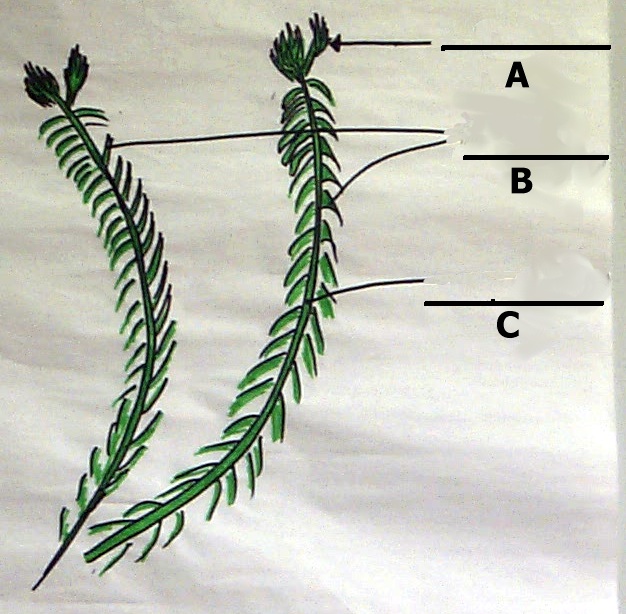SC/SS 115 Ethnobotany Midterm 2004 • Name:
Part One: Plant Identification
Samples of the following plants are labeled with letters. Write the letter in the blank next to the correct name.
- _____ Agathis robustus (kauri)
- _____ Araucaria columnaris (Cook island pine)
- _____ Asplenium nidus (bird's nest fern, nük, muhliklik, tehnlik, chath)
- _____ Coffea arabica
- _____ Cycas rumphii (cycad)
- _____ Dicranopteris linearus (anecha, mwedil en mal)
- _____ Lycopodiella cernua [Lycopodium cernuum] (club moss, unen katu, mac en tefuroh, suhke krismas, kidi en mal or kidi en leng)
- _____ Myristica fragrans (nutmeg)
- _____ Nephrolepis acutifolia (amare, rehdil)
- _____ Nostoc (cyanobacteria, num, fokon faht, pwisehn ketipen)
- _____ Ocimum sanctum (holy basil, warung, aring, kadiring, lamar)
- _____ Phymatosorus scolopendria [Microsorum scolopendria] (chichi, sra kwem kwem, kidou, gob)
- _____ Selaginella
Part Two: Questions
- Label the parts in the image:

- __________
- __________
- __________
- Put the following into order from the botanically most "primitive" to most "evolved":
angiosperms, cyanobacteria, ferns, gymnosperms, lycopodium, mosses.
- As covered in class, gymnosperms have developed two key features that the more "primitive" plants lack. What are those two features?
- On the field trip to the botanic garden we saw three Agathis robustus pines. Lee Ling noted in class that he knows of a fourth tree. Where is that fourth tree?
- Why are there no "baby" Araucaria columnaris trees on the island of Pohnpei?
- Describe the function of fern sori.
- Both Camihla and Meriko presented uses of the plant Clerodendrum inerme (i'ruch, apuoch, ulo, ilau, kwacwak). This healing plant is very important in both Micronesia and Polynesia. Provide one healing use of this plant either in your own culture or in that of Camihla or Meriko.
Part Three: Essay
Read the following paragraphs and then consider the questions that follow in framing your essay:
A baby on an island in Micronesia developed a chest cold. The family treated the baby with traditional plant medicine, but over a span of several days the baby's cough became worse and the baby developed a fever. The baby's lungs started making gurgling sounds when the baby breathed, and its breathing was labored and difficult. The family rushed the baby to the hospital but very sadly it was too late for the baby and the baby died.
A young woman on an island in Micronesia started her monthly flow but it did not stop. The flow, while not heavy, continued for days and the days became weeks. She became severely anemic, thin, and weak. She went to the doctor but the doctor could not determine a cause for the flow. She sought the advice of an elderly woman in her village and the elderly woman made traditional medicine for the young woman. The medicine stopped the menstrual flow and the woman experienced normal periods in the years that followed.
What is the role and usefulness, if any, of traditional plant medicine in this age of modern medicine, doctors, and hospitals? In your essay consider whether traditional medicine should be used, and if used, are there limits to its usage? Support the position you take carefully and within the context of your own experience and culture. Cite examples either way as appropriate. Write thoughtfully, reflect carefully, think critically.

